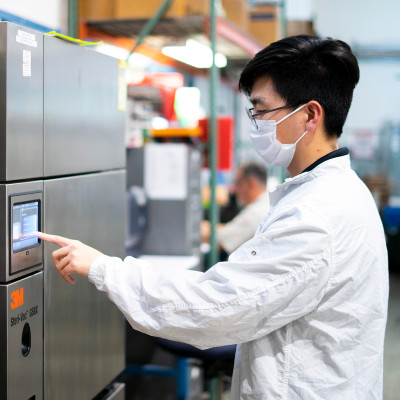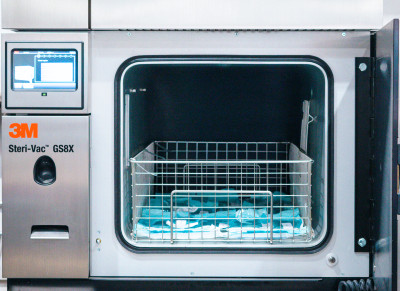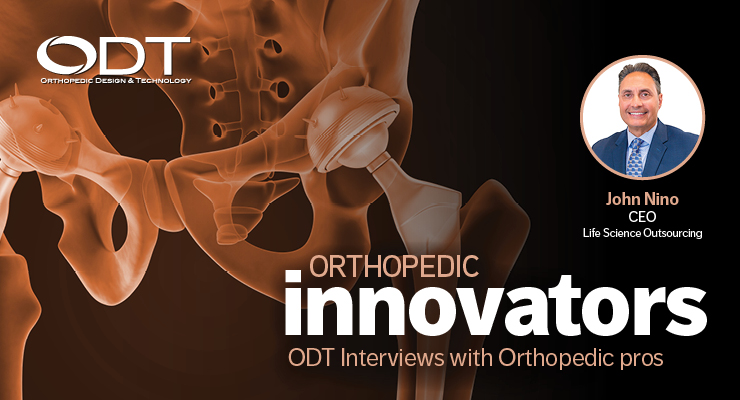Ethylene oxide (EO) is the most commonly used method for sterilizing medical devices, with approximately half of all products using it. While the process offers an array of benefits that make it popular among OEMs for the sterilization of their products, concerns have arisen in recent years regarding its safety and potential impact on the environment around large-scale facilities. As such, the U.S. Environmental Protection Agency and Food and Drug Administration have begun to take a closer look at EO, putting its future in question.
With this in mind, medical device manufacturers (both OEMs and contract manufacturers) have started to explore potential remedies to this challenge. While alternative sterilization options exist, each presents a disadvantage that makes it unlikely to unseat EO as the leading option. One potential solution, however, involves reducing the amount of EO used within the sterilization process.
To explore this situation in greater detail, John Nino, CEO of Life Science Outsourcing, offers his insights on a number of questions around this problem. In this Q&A, he explains the concerns over the situation, sterilization alternatives (the good and the bad of them), and the aforementioned potential solution.
Sean Fenske: Can you briefly explain what the concerns are over ethylene oxide (EO) sterilization?

Sterilization technician programming the EO sterilizer for small batch sterilization.
As far as emissions, the U.S. Environmental Protection Agency (EPA) enforces the Clean Air Act regulations for sterilization facilities. They are expected to release a new 2022 proposal with regard to EO standards. The FDA (Food and Drug Administration) collaborates with the EPA and recognizes the concerns around ethylene oxide being released into the environment when at unsafe levels, including health and ecological impacts to the surrounding environment.
The EPA’s Integrated Risk Information System (IRIS) identifies and characterizes chemical health hazards, and in combination with other research data, has found long-term EO exposure can have negative health consequences. Long-term exposure to ethylene oxide can irritate the eyes, skin, nose, throat, and lungs, and harm the brain and nervous system (causing effects such as headaches, memory loss, and numbness). Studies show that breathing air containing elevated ethylene oxide levels over many years increases the risk of some types of cancers, including cancers of the white blood cells (such as non-Hodgkin’s lymphoma, myeloma, and lymphocytic leukemia) and breast cancer in females.
Further, EO is a hazardous waste in the air, water, and soil. Additional studies must continue to understand the full impact of such waste, but it is known that EO waste enters the environment through the air. It has not been reported to increase over time in land or marine life as some other hazardous wastes can. Soil studies have offered nothing conclusive, however, it is expected EO is not easily absorbed into sediment due to its chemical properties.
Fenske: If EO was eliminated as a sterilization option due to EPA or FDA regulation, what would the impact be to orthopedic device manufacturers?
Nino: For many medical device companies (including orthopedic device manufacturers) that Life Science Outsourcing supports, sterilization with ethylene oxide may be the only method that effectively sterilizes and does not damage the device during the sterilization process. Medical devices made from certain polymers (plastic or resin), metals, or glass, or that have multiple layers of packaging or hard-to-reach places (for example, catheters) are likely to be sterilized with ethylene oxide.
The FDA is actively working with sterilization experts, medical device manufacturers, and other government agencies to advance innovative ways to sterilize medical devices with lower levels of currently used agents and employ new agents or alternatives while maintaining device safety and effectiveness.
In 2019, the FDA announced two public innovation challenges to encourage the development of novel sterilization methods, which could include new devices or new modalities safe and effective for sterilizing medical devices.
The first challenge—Identify New Sterilization Methods and Technologies—is intended to encourage the development of innovative approaches to device sterilization methods or technologies for medical devices that do not rely on ethylene oxide.
The second challenge—Reduce Ethylene Oxide Emissions—has a goal of developing strategies or technologies to reduce emissions to as close to zero as possible from the ethylene oxide sterilization process.

Medical devices go into an EO sterilizer for a sterilization validation.
Fenske: Do you have customers asking about alternatives to EO sterilization?
Nino: Not currently. This is something LSO, which provides large-scale EO sterilization services, will explore. In association with our customers who require our broad array of chamber sizes for their EO needs, we will have to be brought up to date, educated, and comply to any changes in sterilization protocols in the near future. Of course, in the meantime, all processing will remain in accordance with current ISO 11135 requirements.
We are aware, however, of alternatives to EO sterilization in preparation for customer inquiries. Each alternative presents with its own set of advantages and disadvantages:
Hydrogen peroxide vapor or plasma is safe for the environment and employees, has a shorter processing time, leaves no toxic residues, and can be used for heat and moisture sensitive items. It does potentially have material incompatibility with brass, zinc, copper, and nickel/silver plating. Also, it can cause eye damage upon contact and cannot be used for cellulose like linen or paper.
Peracetic acid has environmentally friendly byproducts and is safe for employees. It can potentially have material incompatibility and is only used for immersible instruments.
Gamma radiation offers a 60-year history, has no harmful emissions, sterilizes the entire volume of product, and gas-permeable packaging is not required. It can result in possible harmful changes in some plastics and tissue allografts and requires requalification of irradiator operation annually (approximately). In addition, there’s a question of safety of consumption of irradiated food.
E-beam also has a 60-year history and no harmful emissions. This process uses less product within the irradiator than gamma and has a fast processing time. E-beam is not suitable, however, for products with challenging geometries and localized high-density materials.
Nitrogen dioxide readily penetrates packaging and complex geometry, leaves nontoxic/noncarcinogenic residuals, and has a fast processing time. Unfortunately, it comes with limited compatibility questions with certain plastics and has limited availability.
Fenske: What is Sustainable EO and how does it differ from the traditional method?

Small-batch EO sterilization completed.
- The use of lower levels of ethylene oxide while maintaining assurance devices are safely and effectively sterilized.
- Ethylene oxide emissions are captured and/or transformed to harmless byproducts.
- Detection, measurement, tracking, and containment of fugitive emissions to prevent or minimize emissions into the sterilization facility or environment.
- Safe use of ethylene oxide while minimizing harmful exposure (such as toxicity and carcinogenicity) to sterilization workers and nearby communities.
Traditionally, the D-value of BIs (biological indicator) is typically established with an EO concentration of 600 mg/L at 54°C, but for the sustainable EO cycle, industrial EO processes may be qualified at a range of temperatures and concentrations based on specific product limitations. Furthermore, studies have been published demonstrating that although lethality increases with higher EO concentrations, the increased lethality tails off after 400 mg/L and has minor impact above 500 mg/L. This is the basis for being able to support companies shifting from utilizing traditionally high EO concentrations (600 to 750 mg/L) to those at or below 400 mg/L.
Fenske: Are revalidations required if a company shifts to Sustainable EO? If so, is this something an organization like Life Science Outsourcing assists with?
Nino: The unfortunate answer is “Yes”; any change needs to be reviewed and subjected to verification and/or validation. A recommended approach would be to perform a risk assessment of any changes. Typically, the change will be a reduction in the current process such as reduced EO concentration, reduced processing time, and/or reduced EO exposure time. Hence, the legacy process will remain a worst-case as parameters such as temperature, humidity, and vacuum depth will be unchanged. As the Sustainable EO program involves a full validation compliant with ISO 11135:2014, a minimum SAL (sterility assurance level) will be demonstrated and EO residuals will be assessed per ISO 10993-7:2008. This is something an organization like Life Science Outsourcing (LSO) specializes in and can assist with.
LSO has partnerships with major large batch sterilization contract facilities. Sustainable EO cycles will be validated and implemented by LSO within a "Validation Period”; this will be the new normal going forward. Contract sterilization facilities are now building into their contracts the right to reserve to refuse to process non-sustainable EO cycles following the Validation Period. Capacity will not be secured for such cycles. This will be the cost of doing business, but LSO is confident it can support customers in this journey to the Sustainable EO cycle.
Fenske: What capabilities and/or service offerings can be provided to a company that complements Sustainable EO?
Nino: New service offerings will include the addition of validation support in compliance with ISO 11135:2014 that complements sustainable EO (a cycle less than 400 mg/L EO concentration). LSO can partner both with the sponsor and the contract sterilization technical teams to perform the validation work and new cycle development, which will be subject to their review and approval.
Fenske: Do you have any additional comments you’d like to share based on any of the topics we discussed or something you’d like to tell orthopedic device manufacturers?
Nino: It is important orthopedic device/instrument OEMs and contract manufacturers prepare for upcoming changes to large-lot EO sterilization guidelines being imposed to address EPA and FDA environmental and occupational safety concerns. The resulting changes to Sustainable EO cycles will require OEMs to either revalidate under sustainable concentration levels, transition to small-batch EO processing, or change to alternative sterilization methods. LSO’s team of sterilization and validation experts are ready to help OEMs navigate through these changes.
Find out more about Life Science Outsourcing>>>>>













